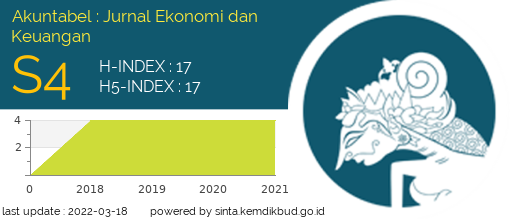Efek spasial infrastruktur terhadap pertumbuhan ekonomi
Abstract
Infrastruktur memiliki peranan yang sangat penting dalam mendorong kinerja perekonomian. Kondisi infrastruktur suatu daerah tidak hanya mempengaruhi perkembangan ekonomi di daerah tersebut tetapi juga daerah di sekitarnya. Penelitian ini bertujuan mengkaji dampak pembangunan infrastruktur terhadap pertumbuhan ekonomi regional dan dalam konteks ekonomi regional, suatu daerah tidak dapat diperlakukan sebagai unit ekonomi yang berdiri sendiri. Adanya interaksi sosial dan ekonomi dari daerah yang berbatasan menyebabkan perkembangan ekonomi suatu daerah turut mempengaruhi kemajuan ekonomi daerah lain. Penelitian ini menggunakan Spatial Durbin Model untuk memperhitungkan efek spillover antar daerah dengan data sampel 34 provinsi di Indonesia dari tahun 2017 – 2019. Hasil estimasi menunjukkan adanya keterkaitan spasial yang positif dan signifikan dari pertumbuhan ekonomi daerah, modal fisik dan modal manusia berpengaruh positif terhadap pertumbuhan ekonomi, infrastruktur jalan berpengaruh negatif, dan infrastruktur telekomunikasi tidak menunjukkan pengaruh yang signifikan terhadap pertumbuhan ekonomi. Selain itu, diperoleh kesimpulan bahwa secara spasial modal manusia berpengaruh negatif dan infrastruktur telekomunikasi berpengaruh positif terhadap daerah yang berbatasan.
Keywords
Full Text:
PDF (Bahasa Indonesia)References
Anselin, L. (2003). Spatial externalities, spatial multipliers, and spatial econometrics. International Regional Science Review, 26(2), 153–166. https://doi.org/10.1177/0160017602250972
Aworinde, O., & Akintoye, I. (2019). Institutions, Infrastructure and Economic Growth in Nigeria. Acta Universitatis Danubius. Œconomica, 15(3), 205–216.
Badan Pusat Statistika. (2018). Statistik Telekomunikasi Indonesia 2018. Badan Pusat Statistik.
Cosci, S., & Mirra, L. (2017). A spatial analysis of growth and convergence in Italian provinces: the role of road infrastructure. Regional Studies, 52(4), 516–527. https://doi.org/10.1080/00343404.2017.1334117
Elburz, Z., Nijkamp, P., & Pels, E. (2017a). Public infrastructure and regional growth: Evidence from turkey. European Journal of Transport and Infrastructure Research, 17(4), 495–507. https://doi.org/10.18757/ejtir.2017.17.4.3211
Elburz, Z., Nijkamp, P., & Pels, E. (2017b). Public infrastructure and regional growth: Lessons from meta-analysis. Journal of Transport Geography, 58, 1–8. https://doi.org/10.1016/j.jtrangeo.2016.10.013
Griffith, D. A. (2009). Spatial Autocorrelation. In International Encyclopedia of Human Geography (pp. 308–316). Elsevier.
Hu, Z., & Luo, S. (2017). Road infrastructure, spatial spillover and county economic growth. IOP Conference Series: Materials Science and Engineering, 231(1). https://doi.org/10.1088/1757-899X/231/1/012028
Konno, A., Kato, H., Takeuchi, W., & Kiguchi, R. (2021). Global evidence on productivity effects of road infrastructure incorporating spatial spillover effects. Transport Policy, 103, 167–182. https://doi.org/https://doi.org/10.1016/j.tranpol.2021.02.007
Lenz, N., Pavlić Skender, H., & Mirković, P. A. (2018). The macroeconomic effects of transport infrastructure on economic growth: the case of Central and Eastern E.U. member states. Economic Research-Ekonomska Istrazivanja, 31(1), 1953–1964. https://doi.org/10.1080/1331677X.2018.1523740
LeSage, J., & Pace, R. K. (2009). Introduction to spatial econometrics. In Introduction to Spatial Econometrics. https://doi.org/10.1111/j.1467-985x.2010.00681_13.x
Li, J., Wen, J., & Jiang, B. (2017). Spatial Spillover Effects of Transport Infrastructure in Chinese New Silk Road Economic Belt. International Journal of E-Navigation and Maritime Economy, 6, 1–8. https://doi.org/10.1016/j.enavi.2017.05.001
Mankiw, G. (2007). Makroekonomi (6th ed.). Erlangga.
Osei-Hwedie, B. Z., & Kurantin, N. (2017). The Impact of Infrastructure on Growth and Development. In R. C. Das (Ed.), Handbook of Research on Economic, Financial, and Industrial Impacts on Infrastructure Development (pp. 84–113). IGI Global. https://doi.org/10.4018/978-1-5225-2361-1.ch005
Permatasari, A. N. (2020). Perekonomian Indonesia Berada di Peringkat 7 Dunia? https://www.kompas.tv/article/68037/perekonomian-indonesia-berada-di-peringkat-7-dunia
Shabani, D. Z., & Safaie, S. (2018). Do transport infrastructure spillovers matter for economic growth? Evidence on road and railway transport infrastructure in Iranian provinces. Regional Science Policy and Practice, 10(1), 49–63. https://doi.org/10.1111/rsp3.12114
Shi, Y., Guo, S., & Sun, P. (2017). The role of infrastructure in China’s regional economic growth. Journal of Asian Economics, 49, 26–41. https://doi.org/10.1016/j.asieco.2017.02.004
Yılmaz, D., & Çetin, I. (2017). The Impact of Infrastructure on Growth in Developing Countries. In R. C. Das (Ed.), Handbook of Research on Economic, Financial, and Industrial Impacts on Infrastructure Development (pp. 40–68). IGI Global. https://doi.org/10.4018/978-1-5225-2361-1.ch003
Refbacks
- There are currently no refbacks.
Copyright (c) 2022 Anisa Fahmi
Editorial Address
Akuntabel: Jurnal Akuntansi dan Keuangan
Faculty of Economics and Business, Mulawarman University
Jl. Tanah Grogot No.1 Samarinda Kalimantan Timur 75119
Email: jakt.feb.unmul@gmail.com
StatCounter: Akuntabel: Jurnal Akuntansi dan Keuangan






